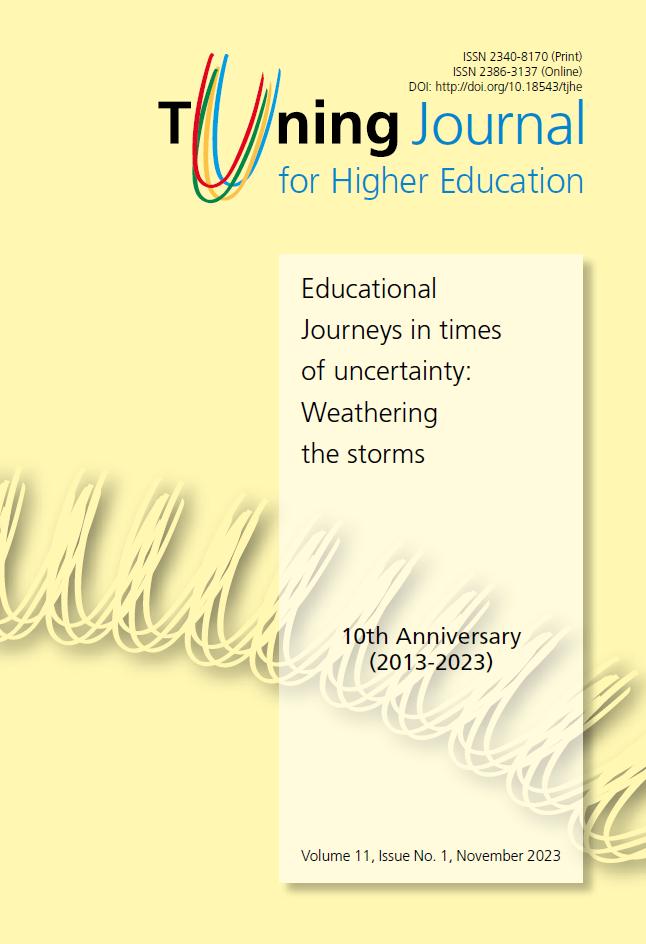Emerging strategies and challenges faced by professors during Emergency Remote Teaching (ERT) at a Colombian university
Abstract
This paper analyzed the relationship between emergent teaching strategies and the challenges professors at Universidad Icesi (Cali, Colombia) faced when transitioning to Emergency Remote Teaching (ERT) during the COVID-19 pandemic. A survey with open-ended questions was used to conduct a content analysis, followed by a correspondence analysis. The main findings were that most professors described submitting information and interaction as the most common teaching strategies. The challenges were primarily emotional and technical in nature. There were differences in discipline, gender, and age. Furthermore, there was no alignment between the challenges and the proposed strategies. Finally, this research has significant implications for future teacher training programs that emphasize faculty diversity.
Received: 16 February 2022
Accepted: 24 July 2023
Downloads
References
Ahmed, Vian, and Alex Opoku. 2021. “Technology Supported Learning and Pedagogy in Times of Crisis: The Case of COVID-19 Pandemic.” Education and Information Technologies, 1–41.
Al-Maroof, Rana Saeed, Said A Salloum, Aboul Ella Hassanien, and Khaled Shaalan. 2020. “Fear from COVID-19 and Technology Adoption: The Impact of Google Meet during Coronavirus Pandemic.” Interactive Learning Environments 31 (3): 1–16. https://doi.org/10.1080/10494820.2020.1830121.
Anderson, Terry, Stanley Varnhagen, and Katy Campbell. 1998. “Faculty Adoption of Teaching and Learning Technologies: Contrasting Earlier Adopters and Mainstream Faculty.” The Canadian Journal of Higher Education, 71–98.
Angelino, Lorraine M, Frankie Keels Williams, and Deborah Natvig. 2007. “Strategies to Engage Online Students and Reduce Attrition Rates.” Journal of Educators Online 4 (2): 1–14.
Aristovnik, Aleksander, Damijana Keržič, Dejan Ravšelj, Nina Tomaževič, and Lan Umek. 2020. “Impacts of the COVID-19 Pandemic on Life of Higher Education Students: A Global Perspective.” Sustainability 12 (20). https://doi.org/10.3390/su12208438.
Bower, Beverly L, and Kimberly P Hardy. 2004. “From Correspondence to Cyberspace: Changes and Challenges in Distance Education.” New Directions for Community Colleges 2004 (128): 5–12. https://doi.org/10.1002/cc.169.
Cahyadi, Ani, and Sri Widyastuti. 2022. “COVID-19, Emergency Remote Teaching Evaluation: The Case of Indonesia.” Education and Information Technologies 27 (2): 2165–79. https://doi.org/10.1007/s10639-021-10680-3.
Chung, Jae Eun, Namkee Park, Hua Wang, Janet Fulk, and Margaret McLaughlin. 2010. “Age Differences in Perceptions of Online Community Participation among Non-Users: An Extension of the Technology Acceptance Model.” Computers in Human Behavior 26 (6): 1674–84. https://doi.org/10.1016/j.chb.2010.06.016.
Creswell, John W. 2009. “Mapping the Field of Mixed Methods Research.” Journal of Mixed Methods Research.
Dorfsman, Marcelo, and Gabriel Horenczyk. 2021. “The Coping of Academic Staff with an Extreme Situation: The Transition from Conventional Teaching to Online Teaching.” Education and Information Technologies 27: 267–89. https://doi.org/10.1007/s10639-021-10675-0.
Duncan, Heather E, and Suzanne Young. 2009. “Online Pedagogy and Practice: Challenges and Strategies.” The Researcher 22 (1): 17–32.
Durrington, Vance A, Amy Berryhill, and Jeanne Swafford. 2006. “Strategies for Enhancing Student Interactivity in an Online Environment.” College Teaching 54 (1): 190–93. https://doi.org/10.3200/CTCH.54.1.190-193.
Ferri, Fernando, Patrizia Grifoni, and Tiziana Guzzo. 2020. “Online Learning and Emergency Remote Teaching: Opportunities and Challenges in Emergency Situations.” Societies 10 (4): 86. https://doi.org/10.3390/soc10040086.
Gibson, Shanan G, Michael L Harris, and Susan M Colaric. 2008. “Technology Acceptance in an Academic Context: Faculty Acceptance of Online Education.” Journal of Education for Business 83 (6): 355–59. https://doi.org/10.3200/JOEB.83.6.355-359.
Greenacre, Michael. 2000. “Correspondence Analysis of Square Asymmetric Matrices.” Journal of the Royal Statistical Society: Series C (Applied Statistics) 49 (3): 297–310.
Greenacre, Michael. 2017. Correspondence Analysis in Practice. CRC press.
Greenhow, Christine, and Sarah Galvin. 2020. “Teaching with Social Media: Evidence-Based Strategies for Making Remote Higher Education Less Remote.” Information and Learning Sciences 121 (7/8): 513–24. https://doi.org/10.1108/ILS-04-2020-0138.
Heilporn, Géraldine, Sawsen Lakhal, and Marilou Bélisle. 2021. “An Examination of Teachers’ Strategies to Foster Student Engagement in Blended Learning in Higher Education.” International Journal of Educational Technology in Higher Education 18 (1): 1–25. https://doi.org/10.1186/s41239-021- 00260-3.
Hodges, Charles, Stephanie Moore, Barb Lockee, Torrey Trust, and Aaron Bond. 2020. “The Difference between Emergency Remote Teaching and Online Learning.” EDUCAUSE Review 3.
International Telecommunication Union. 2019. “Measuring Digital Development.”
Jung, Insung, Sawa Omori, Walter P Dawson, Tomiko Yamaguchi, and Seunghun J Lee. 2021. “Faculty as Reflective Practitioners in Emergency Online Teaching: An Autoethnography.” International Journal of Educational Technology in Higher Education 18 (1): 1–17. https://doi.org/10.1186/s41239-021-00261-2.
Khan, Sarah, Mona El Kouatly Kambris, and Hamda Alfalahi. 2021. “Perspectives of University Students and Faculty on Remote Education Experiences during COVID-19-a Qualitative Study.” Education and Information Technologies 27: 4141–69. https://doi.org/10.1007/s10639-021-10784-w.
Kovacs, Helena, Caroline Pulfrey, and Emilie-Charlotte Monnier. 2021. “Surviving but Not Thriving: Comparing Primary, Vocational and Higher Education Teachers’ Experiences during the COVID-19 Lockdown.” Education and Information Technologies 26 (6): 7543–67. https://doi.org/10.1007/s10639-021-10616-x.
Lee, Thomas W, and Thomas Lee. 1999. Using Qualitative Methods in Organizational Research. Sage.
McFarland, Daniel J. 2001. “The Role of Age and Efficacy on Technology Acceptance: Implications for E-Learning.”
Meishar-Tal, Hagit, and Ariella Levenberg. 2021. “In Times of Trouble: Higher Education Lecturers’ Emotional Reaction to Online Instruction during COVID-19 Outbreak.” Education and Information Technologies 26 (6): 7145–61. https://doi.org/10.1007/s10639-021-10569-1.
Mishra, Lokanath, Tushar Gupta, and Abha Shree. 2020. “Online Teaching-Learning in Higher Education during Lockdown Period of COVID-19 Pandemic.” International Journal of Educational Research Open 1: 100012. https://doi.org/10.1016/j.ijedro.2020.100012.
Mohmmed, Abdalellah O, Basim A Khidhir, Abdul Nazeer, and Vigil J Vijayan. 2020. “Emergency Remote Teaching during Coronavirus Pandemic: The Current Trend and Future Directive at Middle East College Oman.” Innovative Infrastructure Solutions 5 (3): 1–11. https://doi.org/10.1007/s41062-020-00326-7.
Rahim, Ahmad Fuad Abdul. 2020. “Guidelines for Online Assessment in Emergency Remote Teaching during the COVID-19 Pandemic.” Education in Medicine Journal 12 (2): 59–68. https://doi.org/10.21315/eimj2020.12.2.6.
Ramlo, Susan. 2021. “The Coronavirus and Higher Education: Faculty Viewpoints about Universities Moving Online during a Worldwide Pandemic.” Innovative Higher Education 46 (3): 241–59. https://doi.org/10.1007/s10755-020-09532-8.
Rogers, Everett M. 2010. Diffusion of Innovations. Simon and Schuster.
Safi, Farshid, Taylar Wenzel, and Lee-Anne Trimble Spalding. 2020. “Remote Learning Community: Supporting Teacher Educators during Unprecedented Times.” Journal of Technology and Teacher Education 28 (2): 211–22.
Shi, Min, Curtis J Bonk, and Richard J Magjuka. 2006. “Time Management Strategies for Online Teaching.” International Journal of Instructional Technology and Distance Learning 3 (2): 3–10.
Smalley, Andrew. 2021. “Higher Education Responses to Coronavirus (COVID-19).” 2021. https://www.ncsl.org/education/higher-education-responses-to-coronavirus-covid-19.
Spoel, Irene van der, Omid Noroozi, Ellen Schuurink, and Stan van Ginkel. 2020. “Teachers’ Online Teaching Expectations and Experiences during the Covid19- Pandemic in the Netherlands.” European Journal of Teacher Education 43 (4): 623–38. https://doi.org/10.1080/02619768.2020.1821185.
Svrcek, Natalie Sue, Logan Rath, Kathleen Olmstead, and Kathleen Colantonio- Yurko. 2021. “‘We Are Still Putting out Fires’: Considering Educator Intentionality in Remote Instruction during the COVID-19 Pandemic.” Education and Information Technologies 27 (1): 407–28. https://doi.org/10.1007/s10639-021-10679-w.
Talidong, Karen Joy. 2020. “Implementation of Emergency Remote Teaching (ERT) among Philippine Teachers in Xi’an, China.” Asian Journal of Distance Education 15 (1): 196–201.
Tarhini, Ali, Kate Hone, and Xiaohui Liu. 2014. “Measuring the Moderating Effect of Gender and Age on E-Learning Acceptance in England: A Structural Equation Modeling Approach for an Extended Technology Acceptance Model.” Journal of Educational Computing Research 51 (2): 163–84. https://doi.org/10.2190/EC.51.2.b.
Whalen, Jeromie. 2020. “Should Teachers Be Trained in Emergency Remote Teaching? Lessons Learned from the COVID-19 Pandemic.” Journal of Technology and Teacher Education 28 (2): 189–99.
World Economic Forum. 2020. “How COVID-19 Is Driving a Long-Overdue Revolution in Education.”
Xu, Hongjiang, and Sakthi Mahenthiran. 2016. “Factors That Influence Online Learning Assessment and Satisfaction: Using Moodle as a Learning Management System.” International Business Research 9 (2): 1–18. https://doi.org/10.5539/ibr.v9n2p1.
Zayim, Nese, Soner Yildirim, and Osman Saka. 2006. “Technology Adoption of Medical Faculty in Teaching: Differentiating Factors in Adopter Categories.” Journal of Educational Technology & Society 9 (2): 213–22.
Authors are required to sign and submit a copyright transfer agreement after acceptance but before publication of their manuscript. To that effect, they receive, from the Managing Editor of Tuning Journal for Higher Education, a standard copyright assignment form designed along the following lines:
1. Authorship:
The author who signs the copyright transfer agreement must be the sole creator of the work or legally acting on behalf of and with the full agreement of all the contributing authors.
2. Copyright and Code of conduct:
a) Authors warrant that their work is original; has not been previously copyrighted or published in any form; is not under consideration for publication elsewhere; its submission and publication do not violate TJHE Ethical Guidelines for Publication and any codes (of conduct), privacy and confidentiality agreements, laws or any rights of any third party; and no publication payment by the Publisher (University of Deusto) is required.
b) Authors are solely liable for the consequences that may arise from third parties’ complaints about the submitted manuscript and its publication in Tuning Journal for Higher Education (TJHE).
c) Authors grant to the Publisher the worldwide, sub-licensable, and royalty-free right to exploit the work in all forms and media of expression, now known or developed in the future, for educational and scholarly purposes.
d) Authors retain the right to archive, present, display, distribute, develop, and republish their work (publisher's version) to progress their scientific career provided the original publication source (Tuning Journal) is acknowledged properly and in a way that does not suggest the Publisher endorses them or their use of the wortk.
e) Authors warrant that no permissions or licences of any kind will be granted that might infringe the rights granted to the Publisher.
3. Users:
Tuning Journal for Higher Education is an Open Access publication. Its content is free for full and immediate access, reading, search, download, distribution and reuse in any medium or format only for non-commercial purposes and in compliance with any applicable copyright legislation, without prior permission from the Publisher or the author(s). In any case, proper acknowledgement of the original publication source must be made and any changes to the original work must be indicated clearly and in a manner that does not suggest the author’s and or Publisher’s endorsement whatsoever. Any other use of its content in any medium or format, now known or developed in the future, requires prior written permission of the copyright holder.


1.jpg)
1.jpg)
.jpg)
1.jpg)
.jpg)
.jpg)









